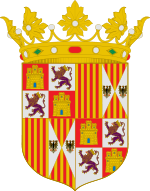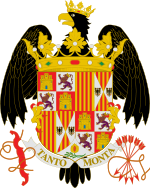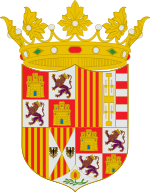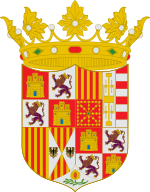Ferdinand II of Aragon
| Ferdinand II & V | |
|---|---|
 |
|
|
|
|
| Reign | 20 January 1479 - 23 January 1516 |
| Predecessor | John II |
| Successor | Joanna and Charles I |
|
|
|
| Reign | 1474 - 1504 |
| Predecessor | Henry IV |
| Successor | Joanna and Philip I |
| Co-monarch | Isabella I |
| Spouse | Isabella I of Castile Germaine of Foix |
| Issue | |
| Isabella, Queen of Portugal John, Prince of Asturias Joanna of Castile Maria, Queen of Portugal Catherine, Queen of England |
|
| House | House of Trastámara |
| Father | John II of Aragon |
| Mother | Juana Enríquez |
| Born | 10 March 1452 Sos del Rey Católico |
| Died | 23 January 1516 (aged 63) Madrigalejo, Extremadura |
| Burial | Capilla Real, Granada, Spain |
| Signature |  |
Ferdinand the Catholic [1] (10 March 1452 – 23 January 1516) was King of Aragon (1479–1516, as Ferdinand II), Sicily (1468–1516), Naples (1504–1516), Valencia, Sardinia, and Navarre, Count of Barcelona, jure uxoris King of Castile (1474–1504, as Ferdinand V, in right of his wife, Isabella) and then Regent of that country also from 1508 to his death, in the name of his mentally unstable daughter Joanna the Mad.
Contents |
Biography
Acquiring titles

Ferdinand was born in Sos del Rey Católico Aragon, and was the son of John II of Aragon (whose family was a cadet branch of the House of Trastámara) by his second wife, Juana Enríquez. He married Infanta Isabella, the half-sister and heiress of Henry IV of Castile, on 19 October 1469 in Valladolid. Isabella also belonged to the royal House of Trastámara, and the two were second cousins by descent from John I of Castile. Married with a clear Prenuptial agreement on sharing power, and under the joint motto, tanto monta, monta tanto. He became jure uxoris King of Castile when Isabella succeeded her deceased brother in 1474 to be crowned as Queen Isabella I of Castile. The two young monarchs were initially obliged to fight a civil war against Joan, princess of Castile (also known as Juana la Beltraneja), the purported daughter of Henry IV, and were swiftly successful. When Ferdinand succeeded his father as King of Aragon in 1479, the Crown of Castile and the various territories of the Crown of Aragon were united in a personal union creating for the first time since the 8th century a single political unit referred to as España (Spain), the root of which is the ancient name Hispania. The various states were not formerly administered as a single unit, but as separate political units under the same Crown. The first people to have both crowns were his daughter Joanna I (in title) and her son Charles V (in power) on Ferdinand's death. The legal merging of Aragon and Castile into a single Spain occurred under a later monarch.
The first decade of Ferdinand and Isabella's joint rule included the conquest of the Nasrid dynasty of the Emirate of Granada (Moorish Kingdom of Granada), the last Islamic al-Andalus entity on the Iberian peninsula, in 1492.

As part of that in the same year, the Alhambra Decree peace treaty was issued, signed with the defeated Moorish Emir of Granada Muhammad XII. It allowed Mudéjar Moors (Islamic) and converso Marrano Jews to stay, while expelling all unconverted Jews from Castile and Aragon. Also in the same year Christopher Columbus was commissioned by the monarchs for an expedition to find a westward maritime route for access to Asia, instead resulting in the European arrival in the Americas. In the 1494 Treaty of Tordesillas the entire world beyond Europe was split between Portugal and Castile (Spain) for conquest and dominion purposes—by two north-south lines down the Atlantic Ocean and the Near East.
Forced conversions
Ferdinand violated the 1492 Alhambra Decree peace treaty in 1502, by dismissing the clearly guaranteed religious freedom for Mudéjar Muslims. Ferdinand forced all Muslims in Castile and Aragon to convert, converso Moriscos, to Catholicism , or else be expelled. Some Muslims that remained were mudéjar artisans, who could design and build in the Moorish style. The Muslims who practiced discreetly were taken by Spanish inquisitors, and were told to eat a piece of pork. This was also practiced by the Spanish inquisitors on the converso Marrano Jewish population of Spain. The Muslims and Jews (Crypto-Judaism) who failed to eat pork were expelled from Spain, executed, or tortured until converting to Catholicism. The main architect behind the Spanish Inquisition was King Ferdinand II. Ferdinand destroyed over ten thousand Arabic manuscripts in Granada alone, burning them. He also converted the Great Mosque of Córdoba into a church, by inserting a chapel in the middle of the mosque.

The latter part of Ferdinand's life was largely taken up with disputes over control of Italy with successive Kings of France, the so-called Italian Wars. In 1494, Charles VIII of France invaded Italy and expelled Alfonso II (who was Ferdinand's first cousin once removed and stepson of Ferdinand's sister) from the throne of Naples. Ferdinand allied with various Italian princes and with Emperor Maximilian I, to expel the French by 1496 and install Alfonso's son, Ferdinand, on the Neapolitan throne. In 1501, following the death of Ferdinand II of Naples and his succession by his uncle Frederick, Ferdinand of Aragon signed an agreement with Charles VIII's successor, Louis XII, who had just successfully asserted his claims to the Duchy of Milan, to partition Naples between them, with Campania and the Abruzzi, including Naples itself, going to the French and Ferdinand taking Apulia and Calabria. The agreement soon fell apart, and over the next several years, Ferdinand's great general Gonzalo Fernández de Córdoba conquered Naples from the French, having succeeded by 1504. Another less famous "conquest" took place in 1503, when Andreas Paleologus, de jure Emperor of the Eastern Roman Empire, left Ferdinand and Isabella as heirs to the empire, thus Ferdinand became de jure Imperator Constantinopolitanus.
| “ | "The King of France complains that I have twice deceived him. He lies, the fool; I have deceived him ten times and more." --Ferdinand II of Aragón.[2] | ” |
After Isabella
After Isabella's death in 1504, her kingdom went to their daughter Joanna. Ferdinand II served as the latter's regent during her absence in the Netherlands, ruled by her husband Archduke Philip. Ferdinand attempted to retain the regency permanently, but was rebuffed by the Castilian nobility and replaced with Joanna's husband, who became Philip I of Castile. After Philip's death in 1506, with Joanna supposedly mentally unstable, and her and Philip's son Charles I of Ghent was only six years old, Ferdinand resumed the regency, ruling through Francisco Jiménez de Cisneros, the Chancellor of the Kingdom. Charles I (to later become Holy Roman Emperor Charles V) became the King of Aragon in 1516, with his mother Joanna as Queen in name, upon Ferdinand's death.
Ferdinand disagreed with the policies and foreigness of Philip I. Ferdinand remarried to Germaine of Foix in 1505, the granddaughter of his half-sister Queen Leonor of Navarre and niece of Louis XII of France. His hope was to father a new heir of Aragon, separating it from Castile, was not realized. It would have denied his son-in- law Philip I, and his grandson Charles I, from inheriting the crown and governance of Aragon.

Ferdinand also had children from his mistress, Aldonza Ruiz de Iborre y Alemany of Cervera. He had a son, Alfonso de Aragon (born in 1469), who later became Archbishop of Saragossa, and a daughter Joanna (born in 1471), who married Bernardino Fernández de Velasco, 1st Duke of Frías.
In the 16th century his son Alfonso de Aragon, who later became Archbishop of Saragossa in Aragon, found a hidden study under Ferdinand's palace containing over 400 documents written by Ferdinand. In these documents Ferdinand explained his general outlook on political power, and his true goals behind all his decisions during life as the King of Castile and Aragon. Also through these documents, Ferdinand wrote that during times of very complicated decision making he blindfolded himself to concentrate on the true matter of a situation, and not let other things 'cloud his judgment'.
In 1508 war resumed in Italy, this time against the Republic of Venice, which all the other powers with interests on the Italian peninsula, including Louis XII, Ferdinand II, Maximilian, and Pope Julius II joined together against as the 'League of Cambrai'. Although the French were victorious against Venice at the Battle of Agnadello, the League of Cambrai soon fell apart, as both the Pope and Ferdinand II became suspicious of French intentions. Instead, the 'Holy League' was formed, in which now all the powers joined together against Louis XII and France.
In November 1511 Ferdinand II and his son-in-law King Henry VIII of England signed the Treaty of Westminster, pledging mutual aid between the two against France. Earlier that year, Ferdinand had conquered the southern half of the Kingdom of Navarre, which was ruled by a French nobleman, and annexed it to Spain. The Holy League was generally successful in Italy, as well, driving the French from Milan, which was restored to its Sforza dukes by the peace treaty in 1513. The French were successful in reconquering Milan two years later, however.
Ferdinand II died in 1516 in Madrigalejo, Extremadura. He is entombed at la Capilla Real or the Royal Chapel of Granada, in Andalucia. Isabell I, Joanna I, and Philip I are beside him there.
Legacy and succession



Ferdinand and Isabella established a highly effective coregency under equal terms. They utilized a prenuptial agreement to lay down their terms. During their reign they supported each other effectively in accordance to their joint motto of equality: Tanto monta or monta tanto, Isabel como Fernando ("They amount to the same, Isabella and Ferdinand"). Isabella and Ferdinand's achievements were remarkable: Spain was united, the crown power was centralized, the reconquista was successfully concluded, the groundwork for the most dominant military machine of the next century and a half was laid, a legal framework was created, the church reformed. Even without the benefit of the American expansion, Spain would have been a major European power. Columbus' discovery set the country on the course for the first modern world power.
In 1502, the members of the Aragonese Cortes gathered in Zaragoza, swore an oath of loyalty to their daughter Joanna as heiress, but the Archbishop of Saragossa stated firmly that this oath was invalid and did not change the law of succession which could only be done by formal legislation by the Cortes with the King.[3][4] So, when King Ferdinand died on 23 January 1516, his daughter Joanna inherited the Crown of Aragon, and his grandson Charles became Governor General (Regent).[5] Nevertheless, the Flemish wished that Charles assume the royal title, and this was supported by his paternal grandfather the Holy Roman Emperor Maximilian I and by Pope Leo X. Consequently, after Ferdinand II's funeral on 14 March 1516, Charles I was proclaimed King of Castile and of Aragon jointly with his mother. Finally, the Castilian Regent, Cardinal Jiménez de Cisneros accepted the fait accompli, and the Castilian and Aragonese Cortes paid homage to him [6] as King of Aragon jointly with his mother.[7]
Family
With his wife Isabella I the Catholic (whom he married 19 October 1469), King Ferdinand had 5 children:
- Isabella of Castile (1470–1498), Princess of Asturias (1497–1498). She married first Prince Afonso, Prince of Portugal, but after his death she married his cousin Prince Emanuel, the future King Emanuel I of Portugal. She died in childbirth delivering her son Michael of Paz, Crown Prince of both Portugal and Spain who, in turn, died in infancy;
- Juan, Prince of Asturias (1478–1497), Prince of Asturias (1478–1497). He married Margaret of Habsburg (daughter of King Maximilian I). He died of tuberculosis and his posthumous child with Margaret was stillborn.
- Joanna I. (1479–1555), Princess of Asturias (1500–1504), Queen of Castile (1504–1555), Queen of Aragon (1516–1555). She married Philip I (Philip the handsome) (son of the Emperor Maximilian I); and was the mother of King Charles I of Spain (also known as Charles V as Holy Roman Emperor). Incarcerated by her father then son in Tordesillas for over 50 years. Her grandson, Philip II of Spain, was crowned 1556.
- Maria of Aragon (1482–1517). She married King Emanuel I of Portugal, the widower of her elder sister Isabella and she was the mother of King John III of Portugal and of the Cardinal-King Henry I of Portugal;
- Catherine of Aragon (1485–1536). She married first Arthur, Prince of Wales, son of and heir to King Henry VII of England and after Prince Arthur's death she married his brother Henry, Duke of York, who also became Prince of Wales and then King Henry VIII. She thus became Queen of England and was the mother of Queen Mary I.
With his second wife, Germaine of Foix, niece of King Louis XII of France (whom he married on 19 October 1505 in Blois) King Ferdinand had one son, John, who died hours after being born on 3 May 1509.
He also left several illegitimate children:
—With Aldonza Ruiz de Iborre y Alemany, a Catalan noblewoman of Cervera:
- Alonso (1470–1520) Spanish Prelate, Archbishop of Saragossa and Viceroy of Aragón;
—With Juana Nicolau:
- Juana (1471 - bef. 1522), married with Bernardino Fernández de Velasco, 1st Duke of Frías
—With Luisa de Estrada:
- Alonso de Estrada (1470–1530). He fought in the Americas.
—With Isabel of Granada (born Aixa, daughter of the vanquished Arab King Muhammad XII of Granada, known as Boabdil):[8]
- Miguel Fernández, the Knight of Granada (1495–1575).
—With Toda de Larrea:
- Maria (? - aft. 1530). Abbess of the Royal Convent of Our Lady Mother of Grace at Avila.
—With N de Pereira:
- Maria (? - Madrigal, 1550). Nun at the Royal Convent of Our Lady Mother of Grace at Avila.
Thus, his grandson Charles, was to inherit not only the Spanish lands of his maternal grandparents, but the Habsburg and Burgundian lands of his paternal family, which would make his heirs the most powerful rulers on the continent and, with the discoveries and conquests in the Americas and elswhere, of the first truly global Empire.
See also: Descendants of Isabella of Castile and Ferdinand of Aragon
Ancestry
| Ancestors of Ferdinand II of Aragon | ||||||||||||||||||||||||||||||||||||||||||||||||||||||||||||||||||||||||||||||||||||||||||||||||||||||||||||||||||||||||||||||||||||||||||||||||||||||||||||||||||||||||||||||||||||||||||||||||||||||||||||||||||||||||||||||||||||||||||||||||||||||||||||||||||||||||||||||||||||||||||||||||||||||||||||||||||||||||||||||||||||||||||||||||||||||||||||||||||||||||||||||||||||||||||||||||||||||||||||||||||||||||||||||||||
|---|---|---|---|---|---|---|---|---|---|---|---|---|---|---|---|---|---|---|---|---|---|---|---|---|---|---|---|---|---|---|---|---|---|---|---|---|---|---|---|---|---|---|---|---|---|---|---|---|---|---|---|---|---|---|---|---|---|---|---|---|---|---|---|---|---|---|---|---|---|---|---|---|---|---|---|---|---|---|---|---|---|---|---|---|---|---|---|---|---|---|---|---|---|---|---|---|---|---|---|---|---|---|---|---|---|---|---|---|---|---|---|---|---|---|---|---|---|---|---|---|---|---|---|---|---|---|---|---|---|---|---|---|---|---|---|---|---|---|---|---|---|---|---|---|---|---|---|---|---|---|---|---|---|---|---|---|---|---|---|---|---|---|---|---|---|---|---|---|---|---|---|---|---|---|---|---|---|---|---|---|---|---|---|---|---|---|---|---|---|---|---|---|---|---|---|---|---|---|---|---|---|---|---|---|---|---|---|---|---|---|---|---|---|---|---|---|---|---|---|---|---|---|---|---|---|---|---|---|---|---|---|---|---|---|---|---|---|---|---|---|---|---|---|---|---|---|---|---|---|---|---|---|---|---|---|---|---|---|---|---|---|---|---|---|---|---|---|---|---|---|---|---|---|---|---|---|---|---|---|---|---|---|---|---|---|---|---|---|---|---|---|---|---|---|---|---|---|---|---|---|---|---|---|---|---|---|---|---|---|---|---|---|---|---|---|---|---|---|---|---|---|---|---|---|---|---|---|---|---|---|---|---|---|---|---|---|---|---|---|---|---|---|---|---|---|---|---|---|---|---|---|---|---|---|---|---|---|---|---|---|---|---|---|---|---|---|---|---|---|---|---|---|---|---|---|---|---|---|---|---|---|---|---|---|---|---|---|---|---|---|---|---|---|---|---|---|---|---|---|---|---|---|---|---|---|---|---|---|---|---|---|---|---|---|---|---|---|---|
|
||||||||||||||||||||||||||||||||||||||||||||||||||||||||||||||||||||||||||||||||||||||||||||||||||||||||||||||||||||||||||||||||||||||||||||||||||||||||||||||||||||||||||||||||||||||||||||||||||||||||||||||||||||||||||||||||||||||||||||||||||||||||||||||||||||||||||||||||||||||||||||||||||||||||||||||||||||||||||||||||||||||||||||||||||||||||||||||||||||||||||||||||||||||||||||||||||||||||||||||||||||||||||||||||||
Heraldry

Monarch of the Crowns of Aragon and Castille. With Queen Isabella. (1474–1492). |

the Catholic Monarchs after the conquest of Granada. With the arms of Granada. (1492–1504). |

Sovereign of Aragon. (c. 1492) |

With the blazons of Jerusalem and Hungary in the arms of Naples. (1504–1512) |

the blazons of Jerusalem and Hungary in the arms of Naples and the arms of Navarre. (1512–1516) |
See also
- History of Spain
- Monarchs of Naples and Sicily
References
- ↑ Spanish: Fernando II de Aragón y V de "el Católico", Catalan: Ferran II d'Aragó "el Catòlic", Aragonese: Ferrando II d'Aragón "lo Catolico"
- ↑ Miles H. Davidson, Columbus then and now: a life reexamined, University of Oklahoma Press 1997, ISBN 9780806129341, p. 474.
- ↑ Estudio documental de la moneda castellana de Carlos I fabricada en los Países Bajos (1517); José María de Francisco Olmos, Revista General de Información y Documentación 2003, vol 13, núm.2 (Universidad complutense de Madrid), page 137
- ↑ Estudio documental de la moneda castellana de Juana la Loca fabricada en los Países Bajos (1505-1506); José María de Francisco Olmos, Revista General de Información y Documentación 2002, vol 12, núm.2 (Universidad complutense de Madrid), page 299
- ↑ Estudio documental de la moneda castellana de Carlos I fabricada en los Países Bajos (1517); José María de Francisco Olmos, Revista General de Información y Documentación 2003, vol 13, núm.2 (Universidad complutense de Madrid) page 138
- ↑ Historia general de Españahe was from spain ; Modesto Lafuente (1861), pp. 51-52.
- ↑ Fueros, observancias y actos de corte del Reino de Aragón; Santiago Penén y Debesa, Pascual Savall y Dronda, Miguel Clemente (1866), page 64
- ↑ Comentarios sobre el Libro "The Moors last sight"; Salman Rushdie, Boabdil:The unfortunate: El Zogoybi por Ranjit Singh
- ↑ 9.0 9.1 Lundy, Darryl, thePeerage, http://www.thepeerage.com/p10588.htm#i105871, retrieved 2007-10-25
- ↑ 10.0 10.1 Lundy, Darryl, thePeerage, http://www.thepeerage.com/p11347.htm#i113464, retrieved 2007-10-25
- ↑ 11.0 11.1 Lundy, Darryl, thePeerage, http://www.thepeerage.com/p329.htm#i3286, retrieved 2007-10-25
External links
- "Ferdinand II", from Encyclopædia Britannica Online.
|
Ferdinand II of Aragon
House of Trastámara
Born: 10 March 1452 Died: 23 June 1516 |
||
| Regnal titles | ||
|---|---|---|
| Preceded by John II |
King of Aragon, Valencia, and Majorca, Count of Barcelona 1479–1516 |
Succeeded by Joanna the Mad and Emperor Charles V |
| King of Sicily 1468–1516 |
||
| Preceded by Charles VIII of France |
Count of Roussillon and Cerdagne 1493–1516 |
|
| Preceded by Louis XII of France |
King of Naples 1504–1516 |
|
| Preceded by Catherine and John III |
King of Upper Navarre 1474–1504 |
Merged into Crown of Castile |
| Preceded by Henry IV |
King of Castile and León 1474–1504 with Isabella I |
Succeeded by Joanna and Philip I |
| Titles in pretence | ||
| Preceded by Andreas Palaiologos |
— TITULAR — Byzantine Emperor with Isabella I 1502–1516 Reason for succession failure: The Fall of Constantinople led to the Ottoman conquest of the Byzantine Empire |
Succeeded by Charles V, Holy Roman Emperor |
|
||||||||||||||||||||||||||||||||||||||||||||||||||||||||